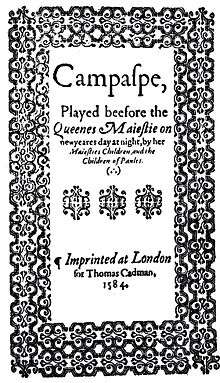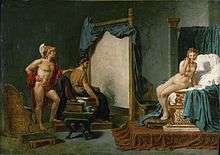Campaspe (play)
Campaspe is an Elizabethan era stage play, a comedy by John Lyly based on the life of Campaspe. Widely considered Lyly's earliest drama, Campaspe was an influence and a precedent for much that followed in English Renaissance drama.

Performance and publication
Campaspe is known to have been performed at Court before Queen Elizabeth I, most likely on 1 January 1584 (new style); it was also acted at the first Blackfriars Theatre. The company that performed the play is open to question: extant records assign the Court performance to "Oxford's boys," and the Blackfriars production to the Children of Paul's, Lyly's regular company, and the Children of the Chapel. One resolution for the conflicting assignments is the theory that the play was acted by a combination of personnel from the Paul's and Chapel companies as well as from the troupe of boy actors maintained in the 1580s by the Earl of Oxford.[1]
Campaspe was first published in a 1584 quarto printed by Thomas Dawson for the bookseller Thomas Cadman. Q1 exists in three different "states" or impressions, with slight differences among them. The first, Q1a, titles the play A moste excellent Comedie of Alexander, Campaspe, and Diogenes.In the subsequent impressions, Q1b and Q1c, the play's title is shortened to Campaspe. The running title of all three impressions (printed along the tops of the text's pages) is A tragical Comedie [sic] of Alexander and Campaspe. (Editors and scholars of the eighteenth and nineteenth centuries generally referred to the play as Alexander and Campaspe; their twentieth-century counterparts tend to prefer the shorter title.)
A second quarto edition appeared in 1591, printed by Thomas Orwin for the bookseller William Broome. The play would also be included in Six Court Comedies (1632), the earliest collected edition of Lyly's plays, printed by William Stansby for Edward Blount.[2] Blount's edition printed the texts of the plays' songs, which were omitted from the earlier quartos – including the often reprinted "Cupid and my Campaspe play'd..."; though scholars have questioned whether these songs are authentically Lylian in authorship.
(Alternatively, the three states of Q1, similar as they are, have been regarded as three separate quartos, Q1-3, and the 1591 edition as Q4.)[3]
Sources
Lyly depended on the Natural History of Pliny the Elder for the tale of Alexander the Great and Campaspe. He also drew upon the work of Diogenes Laërtius and upon Thomas North's 1580 translation of the Parallel Lives of Plutarch for information of the philosophers of ancient Greece — he includes not only Diogenes but also Plato, Aristotle, Cleanthes, Crates, Chrysippus, Crysus, and Anaxarchus. (The play must therefore have been written between 1580 and 1584.)
Synopsis

While in Athens, Alexander falls in love with the beautiful Theban captive, Campaspe. He grants the young woman her freedom, and has her portrait painted by the artist Apelles. Apelles quickly falls in love with her too; when the portrait is finished, he deliberately mars it to have more time with his sitter. Campaspe in turn falls in love with Apelles. When Apelles eventually presents the completed portrait to Alexander, the painter's behaviour reveals that he is in love with Campaspe. Alexander magnanimously resigns his interest in Campaspe so that the true love between her and Apelles can flower; he turns his attention to the invasion of Persia and further conquests.
Alexander also spends his time in Athens conversing and consorting with the philosophers of the era – most notably with Diogenes, whose famous tub is prominently featured onstage. Diogenes is little impressed with the conqueror. Aristotle and Plato share a conversation, and other philosophers appear as well. The play also features the witty pages that are a hallmark of Lyly's drama.
The play's prose style is heavily "euphuistic," sharing significant commonalities with Lyly's famous novel Euphues (1578). Notably, Apelles is a crucial figure in both works. This euphuistic style helps to support the view that Campaspe was Lyly's first venture at writing for the stage.
Influence
Lyly provides no moral or ethical lesson in his Campaspe — thereby breaking away from the morality play tradition of earlier drama. And unlike most of his subsequent plays, Campaspe eschews allegory as well. Instead, Campaspe delivers a romantic historical tale purely for its entertainment value. His departure from the Medieval mindset provided a model for later (and better) writers to follow. The play has been called "the first romantic drama" of its era.[4]
Thomas Nashe quotes from Campaspe in his play Summer's Last Will and Testament (1592).
References
- E. K. Chambers, The Elizabethan Stage, 4 Volumes, Oxford, Clarendon Press, 1923; Vol. 2, pp. 17, 39–40.
- Chambers, Vol. 3, pp. 413–14.
- G. K. Hunter and David Bevington, eds. Campaspe; Sapho and Phao, The Revels Plays, Manchester, Manchester University Press, 1999; pp. 1–4.
- John Dover Wilson, John Lyly, Cambridge, Macmillan and Bowes, 1905; p. 100.